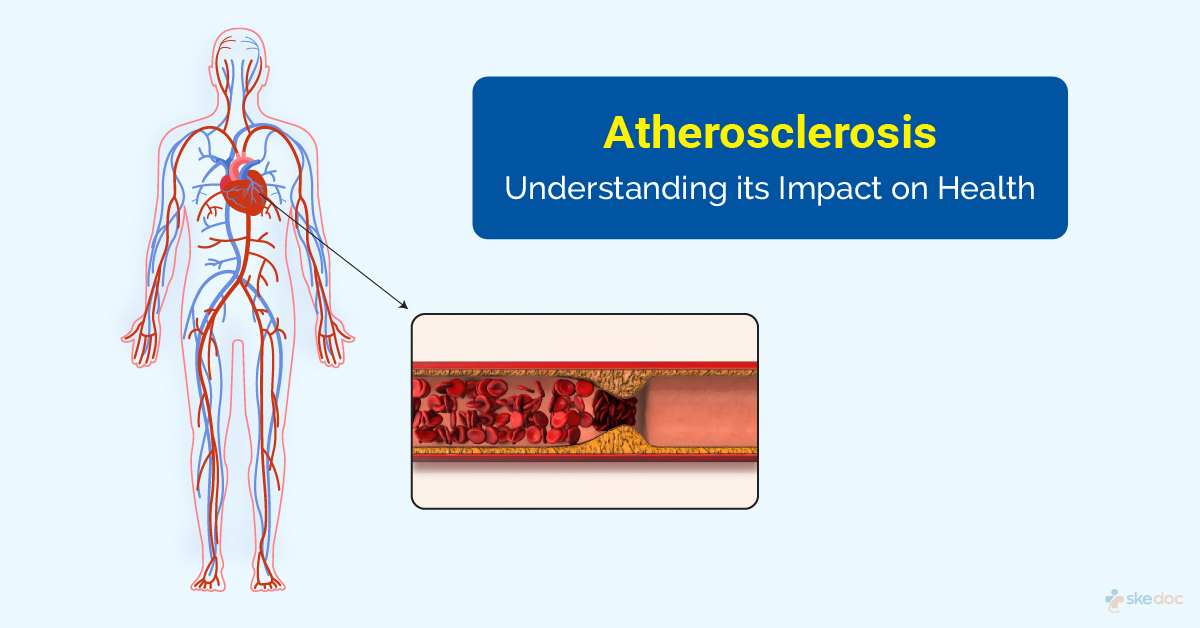Allergy
Blood Diseases
Bone & Joints
Brain
Cancer
Child Care
Cosmetic Surgery
Diabetes
Endocrinology
ENT
Eye
Gen Medicine
General Surgery
Heart
Kidney
Lifestyle
Liver & Digestive
Lung
Men’s Health
Mental health
Physiotherapy
Rheumatology
Skin and hair
Sleep Disorders
Spine
Transplant
Women Health
Thyroid
Vascular Surgery
Atherosclerosis

What is Atherosclerosis?
Atherosclerosis is a condition affecting the blood vessels due to the buildup of fats, calcium, and fibrous tissue, which narrows the gap inside them and prevents the proper flow of blood. The condition of arteriosclerosis, which is the gradual loss of elasticity, with thickening and hardening of the blood vessel walls, is compounded by the presence of atheromatous plaques leading to atherosclerosis.
Alternate names
- Arteriosclerosis
Is this condition a medical emergency?
Atherosclerosis is not a medical emergency but can result in conditions that warrant immediate medical attention.
Types of this condition
Atherosclerosis is of the following types:
- Non-atherosclerotic Intimal lesions
- Progressive atherosclerotic lesions
- Atherosclerotic lesions with acute thrombi (blood clots)
- Atherosclerotic lesions with healed thrombi
Causes
The exact cause of atherosclerosis is not fully understood. An initial small injury to the innermost blood vessel wall results in the accumulation of macrophage cells (as a result of inflammation), lipids, calcium, and fibrous connective tissue between the innermost layer and the middle layer, and is called an atheromatous plaque, plaque, or an atheroma.
In the early stages, the middle layer of the blood vessel wall stretches to accommodate the plaque, but over time, as the size of the plaque grows, the blood vessel can no longer stretch, resulting in the narrowing of the blood vessel. In some cases, the plaque tears open the innermost layer, and this results in the formation of a blood clot or thrombus. If the combination of the blood clot and the plaque is large enough, it may result in either a marked reduction or blockage of blood flow in that blood vessel. In some cases, the blood clot or the plaque may break off and travel to another blood vessel, resulting in a blockage. Some of the probable causes include:
- Hypertension
- High cholesterol and triglycerides
- Smoking
- Obesity
- Diabetes and insulin resistance
- Inflammatory systemic diseases such as arthritis, lupus, etc.
Risk factors
The risk factors for atherosclerosis are as follows:
- Diabetes
- Insulin resistance
- Obesity
- Hypertension
- Smoking
- High cholesterol and lipids in the blood
- Advancing age
- Male gender
- Genetic abnormalities
- Family history
- A sedentary lifestyle and lack of exercise
- Chronic stress
- Hypothyroidism
- A disease of the gums
- Sleep deprivation
- Unhealthy diet and eating habits
Symptoms & signs
Atherosclerosis is a slow process that develops over a long time. There are usually no signs and symptoms until the blood flow through the affected vessel is significantly reduced or blocked. The symptoms and signs depend on which arteries are affected and the organs they supply. The following may be seen:
- Arteries supplying the heart are affected: The symptoms of a heart attack, such as chest pain, shortness of breath, etc, may be seen.
- Arteries supplying the brain are affected: The symptoms of a transient ischemic attack, such as numbness or weakness of limbs, slurring of speech, and visual disturbances, may be seen.
- Arteries supplying the arms or legs are affected: The symptoms of the peripheral arterial disease, such as pain on movement, may be seen.
- Arteries supplying the kidneys are affected: The symptoms of renal failure or high blood pressure may be seen.
Investigations
The following investigations may be done:
- Laboratory tests
- Lipid profile: To test for cholesterol and other lipid levels in the blood.
- Blood sugar: Fasting, post-lunch, and HbA1C
- Serum C reactive Protein
- Serum homocysteine
- Ankle Brachial Index: Comparison of the blood pressure in the arm to the blood pressure in the legs; useful in peripheral arterial disease.
- Electrocardiogram: To check the function and status of the heart.
- Stress Test: To assess the effect of physical activity on the heart's function.
- Ultrasound
- Doppler ultrasound: To gauge the degree of blockages by checking the pressure of blood flow at various points
- Intravascular ultrasound (IVUS): To visualize the interior of the blood vessels
- Stress Echocardiogram
- Carotid IMT (intimal medial thickness): To check the carotid arteries supplying the brain.
- Cardiac CT or Cardiac MRI
- Cardiac catheterization and angiogram
Diagnosis of atherosclerosis
Diagnosis is established based on clinical examination and the results of the investigations done.
Treatment options
The treatment of atherosclerosis is aimed at slowing or reversing the process of atherosclerosis through lifestyle changes and medication. Surgical intervention may be required if the narrowing of occlusion needs to be addressed on an immediate basis to restore organ function or to prevent potentially fatal complications.
Medical management
Medical management of atherosclerosis involves the use of the following medications, either singly or in combination
- Statins: They act as cholesterol modifiers and lipid-lowering drugs.
- Anti-platelet agents: Such as aspirin, prevent the formation of blood clots.
- Beta-blockers: To reduce the heart rate and blood pressure and decrease the load on the hearing.
- ACE inhibitors: To slow the process of atherosclerosis and to reduce blood pressure.
- Diuretics: To lower blood pressure.
- Calcium channel blockers: To lower blood pressure.
Interventional including surgery and indications for surgery
Surgical intervention may be required if the blood flow is severely reduced or if a blockage affects the function of the organs or tissues. Some of the procedures that may be done include:
- Angioplasty and stenting: A minimally invasive interventional cardiology procedure in which a balloon is guided through a catheter to unblock or widen the arteries, a tiny tubular mesh made of metal (stent) is placed inside the artery to act as a support and keep the artery open.
- Endarterectomy: This is the surgical removal of plaque or fatty deposits from the walls of the blood vessels.
- Bypass surgery: Involves the use of a graft made from another artery to bypass the blockage and restore circulation.
- Fibrinolytic therapy: Involves the use of clotting breaking agents that are surgically introduced at the site of the blockage.
Role of Diet/Exercise/Lifestyle changes/Preventive measures
Some measures that can be taken to prevent as well as manage atherosclerosis include:
- Cessation of smoking
- Maintaining an ideal body weight
- Regular exercise
- Eating healthy and nutritious food
- Keeping diabetes, hypertension, and cholesterol under control
- Reducing emotional and mental stress
Complications
The complications of atherosclerosis may be as follows:
- Aneurysms
- Angina
- Chronic kidney disease
- Coronary artery disease
- Heart attack
- Heart failure
- Peripheral artery disease
- Stroke
- Abnormal heart rhythms
Prognosis
The prognosis of atherosclerosis depends on how early it is diagnosed, how well it is managed, the severity of the condition, and the organ or organs that are being affected. Atherosclerosis that is identified early and managed well has a good prognosis.
When to contact the doctor or hospital/How to identify the emergency or complications?
It is advisable to seek medical attention if there are any symptoms and signs related to atherosclerosis and if there are risk factors for its development. Early diagnosis and treatment can help to prevent the progression of the disease and prevent future complications.
Indications for hospitalization if required
Hospitalization is not needed for atherosclerosis unless it has resulted in a condition that requires immediate medical attention or intervention.
Suggested clinical specialist/Departments to consult for this condition
Specialists from the Department of Cardiology or Vascular Medicine will attend to atherosclerosis.
Was this article helpful?
YesNo




